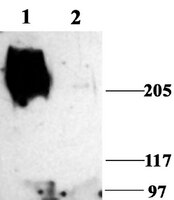Effective contractile response to voltage-gated Na+ channels revealed by a channel activator.
Ho, WS; Davis, AJ; Chadha, PS; Greenwood, IA
American journal of physiology. Cell physiology
304
C739-47
2013
概要を表示する
This study investigated the molecular identity and impact of enhancing voltage-gated Na(+) (Na(V)) channels in the control of vascular tone. In rat isolated mesenteric and femoral arteries mounted for isometric tension recording, the vascular actions of the Na(V) channel activator veratridine were examined. Na(V) channel expression was probed by molecular techniques and immunocytochemistry. In mesenteric arteries, veratridine induced potent contractions (pEC(50) = 5.19 ± 0.20, E(max) = 12.0 ± 2.7 mN), which were inhibited by 1 μM TTX (a blocker of all Na(V) channel isoforms, except Na(V)1.5, Na(V)1.8, and Na(V)1.9), but not by selective blockers of Na(V)1.7 (ProTx-II, 10 nM) or Na(V)1.8 (A-80347, 1 μM) channels. The responses were insensitive to endothelium removal but were partly (~60%) reduced by chemical destruction of sympathetic nerves by 6-hydroxydopamine (2 mM) or antagonism at the α1-adrenoceptor by prazosin (1 μM). KB-R7943, a blocker of the reverse mode of the Na(+)/Ca(2+) exchanger (3 μM), inhibited veratridine contractions in the absence or presence of prazosin. T16A(inh)-A01, a Ca(2+)-activated Cl(-) channel blocker (10 μM), also inhibited the prazosin-resistant contraction to veratridine. Na(V) channel immunoreactivity was detected in freshly isolated mesenteric myocytes, with apparent colocalization with the Na(+)/Ca(2+) exchanger. Veratridine induced similar contractile effects in the femoral artery, and mRNA transcripts for Na(V)1.2 and Na(V)1.3 channels were evident in both vessel types. We conclude that, in addition to sympathetic nerves, NaV channels are expressed in vascular myocytes, where they are functionally coupled to the reverse mode of Na(+)/Ca(2+) exchanger and subsequent activation of Ca(2+)-activated Cl(-) channels, causing contraction. The TTX-sensitive Na(V)1.2 and Na(V)1.3 channels are likely involved in vascular control. | Immunofluorescence | 23364266
 |
Putative excitatory and putative inhibitory inputs are localised in different dendritic domains in a Drosophila flight motoneuron.
Kuehn, C; Duch, C
The European journal of neuroscience
37
860-75
2013
概要を表示する
Input-output computations of individual neurons may be affected by the three-dimensional structure of their dendrites and by the location of input synapses on specific parts of their dendrites. However, only a few examples exist of dendritic architecture which can be related to behaviorally relevant computations of a neuron. By combining genetic, immunohistochemical and confocal laser scanning methods this study estimates the location of the spike-initiating zone and the dendritic distribution patterns of putative synaptic inputs on an individually identified Drosophila flight motorneuron, MN5. MN5 is a monopolar neuron with greater than 4,000 dendritic branches. The site of spike initiation was estimated by mapping sodium channel immunolabel onto geometric reconstructions of MN5. Maps of putative excitatory cholinergic and of putative inhibitory GABAergic inputs on MN5 dendrites were created by charting tagged Dα7 nicotinic acetylcholine receptors and Rdl GABAA receptors onto MN5 dendritic surface reconstructions. Although these methods provide only an estimate of putative input synapse distributions, the data indicate that inhibitory and excitatory synapses were located preferentially on different dendritic domains of MN5 and, thus, computed mostly separately. Most putative inhibitory inputs were close to spike initiation, which was consistent with sharp inhibition, as predicted previously based on recordings of motoneuron firing patterns during flight. By contrast, highest densities of putative excitatory inputs at more distant dendritic regions were consistent with the prediction that, in response to different power demands during flight, tonic excitatory drive to flight motoneuron dendrites must be smoothly translated into different tonic firing frequencies. | | 23279094
 |
Colocalization of hyperpolarization-activated, cyclic nucleotide-gated channel subunits in rat retinal ganglion cells.
Stradleigh, TW; Ogata, G; Partida, GJ; Oi, H; Greenberg, KP; Krempely, KS; Ishida, AT
The Journal of comparative neurology
519
2546-73
2011
概要を表示する
The current-passing pore of mammalian hyperpolarization-activated, cyclic nucleotide-gated (HCN) channels is formed by subunit isoforms denoted HCN1-4. In various brain areas, antibodies directed against multiple isoforms bind to single neurons, and the current (I(h)) passed during hyperpolarizations differs from that of heterologously expressed homomeric channels. By contrast, retinal rod, cone, and bipolar cells appear to use homomeric HCN channels. Here, we assess the generality of this pattern by examining HCN1 and HCN4 immunoreactivity in rat retinal ganglion cells, measuring I(h) in dissociated cells, and testing whether HCN1 and HCN4 proteins coimmunoprecipitate. Nearly half of the ganglion cells in whole-mounted retinae bound antibodies against both isoforms. Consistent with colocalization and physical association, 8-bromo-cAMP shifted the voltage sensitivity of I(h) less than that of HCN4 channels and more than that of HCN1 channels, and HCN1 coimmunoprecipitated with HCN4 from membrane fraction proteins. Finally, the immunopositive somata ranged in diameter from the smallest to the largest in rat retina, the dendrites of immunopositive cells arborized at various levels of the inner plexiform layer and over fields of different diameters, and I(h) activated with similar kinetics and proportions of fast and slow components in small, medium, and large somata. These results show that different HCN subunits colocalize in single retinal ganglion cells, identify a subunit that can reconcile native I(h) properties with the previously reported presence of HCN4 in these cells, and indicate that I(h) is biophysically similar in morphologically diverse retinal ganglion cells and differs from I(h) in rods, cones, and bipolar cells. | | 21456027
 |




















